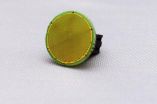(Press-News.org) A study out today in the journal Cell Stem Cell shows that human brain cells created by reprogramming skin cells are highly effective in treating myelin disorders, a family of diseases that includes multiple sclerosis and rare childhood disorders called pediatric leukodystrophies.
The study is the first successful attempt to employ human induced pluripotent stem cells (hiPSC) to produce a population of cells that are critical to neural signaling in the brain. In this instance, the researchers utilized cells crafted from human skin and transplanted them into animal models of myelin disease.
"This study strongly supports the utility of hiPSCs as a feasible and effective source of cells to treat myelin disorders," said University of Rochester Medical Center (URMC) neurologist Steven Goldman, M.D., Ph.D., lead author of the study. "In fact, it appears that cells derived from this source are at least as effective as those created using embryonic or tissue-specific stem cells."
The discovery opens the door to potential new treatments using hiPSC-derived cells for a range of neurological diseases characterized by the loss of a specific cell population in the central nervous system called myelin. Like the insulation found on electrical wires, myelin is a fatty tissue that ensheathes the connections between nerve cells and ensures the crisp transmission of signals from one cell to another. When myelin tissue is damaged, communication between cells can be disrupted or even lost.
The most common myelin disorder is multiple sclerosis, a condition in which the body's own immune system attacks and destroys myelin. The loss of myelin is also the hallmark of a family of serious and often fatal diseases known as pediatric leukodystrophies. While individually very rare, collectively several thousand children are born in the U.S. with some form of leukodystrophy every year.
The source of the myelin cells in the brain and spinal cord is cell type called the oligodendrocyte. Oligodendrocytes are, in turn, the offspring of another cell called the oligodendrocyte progenitor cell, or OPC. Myelin disorders have long been considered a potential target for cell-based therapies. Scientists have theorized that if healthy OPCs could be successfully transplanted into the diseased or injured brain, then these cells might be able to produce new oligodendrocytes capable of restoring lost myelin, thereby reversing the damage caused by these diseases.
However, several obstacles have thwarted scientists. One of the key challenges is that OPCs are a mature cell in the central nervous system and appear late in development.
"Compared to neurons, which are among the first cells formed in human development, there are more stages and many more steps required to create glial cells such as OPCs," said Goldman. "This process requires that we understand the basic biology and the normal development of these cells and then reproduce this precise sequence in the lab."
Another challenge has been identifying the ideal source of these cells. Much of the research in the field has focused on cells derived from tissue-specific and embryonic stem cells. While research using these cells has yielded critical insight into the biology of stem cells, these sources are not considered ideal to meet demand once stem cell-based therapies become more common.
The discovery in 2007 that human skin cells could be "reprogrammed" to the point where they returned to a biological state equivalent of an embryonic stem cell, called induced pluripotent stem cells, represented a new path forward for scientists. Because these cells – created by using the recipient's own skin – would be a genetic match, the likelihood of rejection upon transplantation is significantly diminished. These cells also promised an abundant source of material from which to fashion the cells necessary for therapies.
Goldman's team was the first to successfully master the complex process of using hiPSCs to create OPCs. This process proved time consuming. It took Goldman's lab four years to establish the exact chemical signaling required to reprogram, produce, and ultimately purify OPCs in sufficient quantities for transplantation and each preparation required almost six months to go from skin cell to a transplantable population of myelin-producing cells.
Once they succeeded in identifying and purifying OPCs from hiPSCs, they then assessed the ability of the cells to make new myelin when transplanted into mice with a hereditary leukodystrophy that rendered them genetically incapable of producing myelin.
They found that the OPCs spread throughout the brain and began to produce myelin. They observed that hiPSC-derived cells did this even more quickly, efficiently, and effectively than cells created using tissue-derived OPCs. The animals were also free of any tumors, a dangerous potential side effect of some stem cell therapies, and survived significantly longer than untreated mice.
"The new population of OPCs and oligodendrocytes was dense, abundant, and complete," said Goldman. "In fact, the re-myelination process appeared more rapid and efficient than with other cell sources."
The next stage in evaluating these cells – clinical studies – may not be long in the offing. Goldman, along with a team of researchers and clinicians from Rochester, Syracuse, and Buffalo, are preparing to launch a clinical trial using OPCs to treat multiple sclerosis. This group, titled the Upstate MS Consortium, has been approved for funding by New York State Stem Cell Science (NYSTEM). While the consortia's initial study – the early stages of which are scheduled to begin in 2015 – will focus cells derived from tissue sources, Goldman anticipates that hiPSC-derived OPCs will eventually be included in this project.
###
Additional co-authors of the study include: Su Wang, Janna Bates, Xiaojie Li, Steven Schanz, Devin Chandler-Militello, Corri Levine, and Martha Windrem, all with URMC's Center for Translational Neuromedicine; Nimet Maherali and Konrad Hochedlinger with the Harvard Stem Cell Institute; and Lorenz Studer with the Sloan-Kettering Institute. The study received support from NYSTEM, the National Multiple Sclerosis Society, the National Institute of Neurological Disorders and Stroke, the G. Harold and Leila Y. Mathers Charitable Foundation, and the Dr. Miriam and Sheldon G. Adelson Medical Research Foundation. END
Cells forged from human skin show promise in treating MS, myelin disorders
2013-02-07
ELSE PRESS RELEASES FROM THIS DATE:
Zinc helps against infection by tapping brakes in immune response
2013-02-07
COLUMBUS, Ohio – New research suggests that zinc helps control infections by gently tapping the brakes on the immune response in a way that prevents out-of-control inflammation that can be damaging and even deadly.
Scientists determined in human cell culture and animal studies that a protein lures zinc into key cells that are first-responders against infection. The zinc then interacts with a process that is vital to the fight against infection and by doing so helps balance the immune response.
This study revealed for the first time that zinc homes in on this pathway ...
Study shows disease spread in ladybirds with sexually transmitted disease
2013-02-07
A study at the University of Liverpool into the spread of sexually transmitted infection in ladybirds has shown that disease risk to large populations cannot be predicted without a full understanding of the disease dynamics at small geographical scale.
Scientists investigated a virulent form of infection in the central and northern European populations of the two-spot ladybird to understand the conditions that favoured disease spread. Researchers found that disease burden in two locations of the same habitat – the lime tree - were very different, despite being within ...
New technology may help doctors monitor concussions, aging, and neurological function
2013-02-07
Boston, MA, Feb. 7, 2013 – Doctors routinely track their patients' hand-eye coordination to monitor any neuromuscular deficits, particularly as patients age or when they are injured -- but the tests they have been using to track this kind of information may be subjective and qualitative.
Researchers at the Wyss Institute for Biologically Inspired Engineering at Harvard University, the Beth Israel Deaconess Medical Center, and Hebrew SeniorLife, Boston (BIDMC), recently completed the first clinical study of a new rapid neuroassessment device they developed to quantitatively ...
Unique peptide could treat cancers, neurological disorders, and infectious diseases
2013-02-07
DALLAS – Feb. 7, 2013 – UT Southwestern Medical Center scientists have synthesized a peptide that shows potential for pharmaceutical development into agents for treating infections, neurodegenerative disorders, and cancer through an ability to induce a cell-recycling process called autophagy.
Autophagy is a fundamental recycling process in which intracellular enzymes digest unneeded and broken parts of the cell into their individual building blocks, which are then reassembled into new parts. The role of autophagy is crucial both in keeping cells healthy and in enabling ...
Compound developed by scientists protects heart cells during and after attack
2013-02-07
JUPITER, FL, February 7, 2013 – Using two different compounds they developed, scientists from the Florida campus of The Scripps Research Institute (TSRI) have been able to show in animal models that inhibiting a specific enzyme protects heart cells and surrounding tissue against serious damage from heart attacks. The compounds also protect against additional injury from restored blood flow after an attack, a process known as reperfusion.
The study, which was led by Philip LoGrasso, a professor and senior scientific director of discovery biology at Scripps Florida, appears ...
Social network use reflects East-West disparity
2013-02-07
EAST LANSING, Mich. — The stark contrast between America's "me-first" culture and the "collective-good" mentality in China is reflected in the two countries' use of social networking sites, according to a new study led by a Michigan State University scholar.
U.S. citizens spend more time on the networking sites, consider them to be more important and have more "friends" on the sites, the research found. The most popular social networking site in the United States is Facebook; in China it's Ozone.
Linda Jackson, MSU professor of psychology, said Chinese citizens tend ...
Health costs of income inequality in marriage, jealousy and parenting, humor and conflict
2013-02-07
In time for Valentine's Day, Personality and Social Psychology Bulletin is featuring several new studies all about relationships – including the link between income in marriage and health, the role of jealousy in becoming a parent, and how humor affects romantic couples in conflict.
Being the breadwinner has health costs
Men whose wives earn more income are more likely to use erectile dysfunction medication than those who outearn their wives, even when the inequality is small, according to a new study. Researchers looking at more than 200,000 married couples in Denmark ...
Smart satnav drives around the blue highway blues
2013-02-07
Endlessly frustrated by congested roads, computer scientists at California State University, in Fullerton have developed a satellite navigation system, GeoTNavi, which hooks into historical traffic data and current vehicle movements to find the shortest commute and avoid the traffic jams.
Writing in the latest issue of the International Journal of Data Mining, Modelling and Management, Shawn Wang and colleagues explain how the California highway system is one of the most complicated and busiest highway systems in the USA with well over 83% of urban interstate congestion. ...
Permanent stress can cause type 2 diabetes in men
2013-02-07
Men who reported permanent stress have a significantly higher risk of developing type 2 diabetes than men who reported no stress. This is the finding of a 35-year prospective follow-up study of 7,500 men in Gothenburg, by the University of Gothenburg, Sweden.
Since the 1970s, a large population based cohort study has been undertaken at the Sahlgrenska Academy, University of Gothenburg to monitor the health of men born in Gothenburg between 1915 and 1925.
Using this unique material, researchers are now able to show that permanent stress significantly increases the risk ...
A Spanish breakthrough allows the electroporation of cell cultures for less than 1 Euro
2013-02-07
Researchers from the Polytechnic University of Catalonia have developed a technique that improves and cuts the cost of a technique called electroporation, which involves opening pores in cell membranes using an electric field to introduce substances like drugs and DNA. Current methods are aggressive and expensive whereas the new system manages to apply low voltage electroporation with a small printed circuit board, which costs less than a Euro per unit and does not damage cells.
Two US firms in Boston and San Francisco operating in the biotechnology equipment sector have ...



